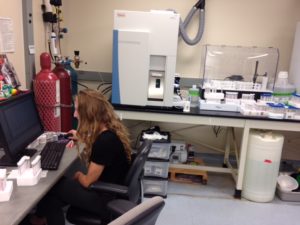After a lot of time out and about last week, it was time to reel it back in for this week. I started writing a research paper on one of the experiments I helped with, describing the process of testing leaching experiments on Archean Shale. In the paper I recount why all this research is so interesting, depicting the procedure of making a synthetic euxinic (lacking oxygen) rock composition from billions of years ago. To do so, you mix concentrations of shale and continental crust (rock) together so that the elemental count is known. Then when the leaching is performed, we can tell if it was a success or not based on how much of the element Molybdenum comes out. Leaching is a new experimental process, which is why we are testing it.
In the paper, I also have to discuss the results and what they mean. For those of you that have written scientific papers before, you will know that it is quite difficult to write intensely concise, with an excessive amount of information, and have the paragraphs sound coherent and intelligent. Well at least, this is what I am struggling with.
Here is a bit of the introduction that I have written so far:
Since the Great Oxidation Event (GOE), free oxygen has been sustained in the Earth’s atmosphere. Although the GOE is marked as the turning point in oxygen history, over 100 million years preceding the event, evidence for small amounts of oxygen was discovered in the form of anomalous molybdenum (Mo) concentrations in black shales (Anbar, 2007). Understanding what drives these “whiffs” of oxygen may give insight into how planets become habitable worlds, possibly with GOEs of their own.
Mo is oxidatively weathered from the continental crust and very stable in oxic waters, and thus very abundant in the modern, well oxygenated, ocean. In euxinic environments, however, Mo is readily removed from the water column and incorporated into underlying sediments. Because of these Mo systematics, enrichments in marine sediments deposited prior to the GOE have the power to provide information on the distribution of free oxygen before the event took place. In addition to Mo concentrations, Mo isotope analyses of these same rocks has proven useful as proxy for ancient oxygen because this composition mirrors that of overlying water and is sensitive to marine oxygenation. To date, it has proven difficult to discern detrital from authigenic Mo in Archean shale samples, due to low authigenic contents, and thus properly gauge the Mo isotope composition of overlying waters.
To more accurately determine ancient oxygen levels through Mo isotope composition, a reliable method of separating the two fractions must be developed. Leaching is one possible approach to this problem. Successful leaching should separate the two fractions through chemistry. However, it is unknown to which extent Mo will be removed from each fraction. Here, we utilize a previously proposed method (Xu et al., 2012) to test leaching of Mo fractions in Archean shales.
I also celebrated my birthday this week. Teresa and Jay brought me to an Italian restaurant and I had this cookie pizza with ice cream to blow my wishes out over. With my second to last week over, I can’t help but feeling sad over my return home soon, although I am quite excited to experience cold again.




There are no comments published yet.